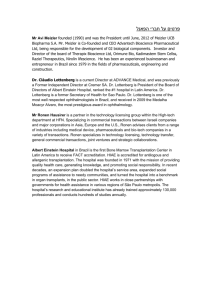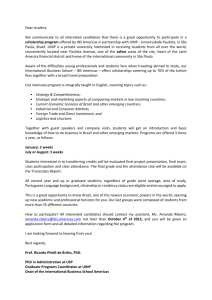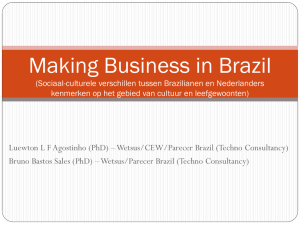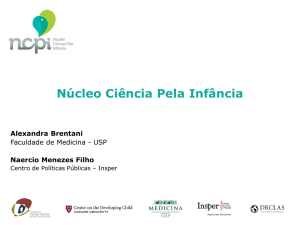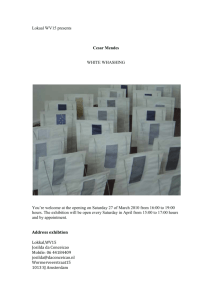Bioactivity of Selenium-Enriched Brassica
advertisement
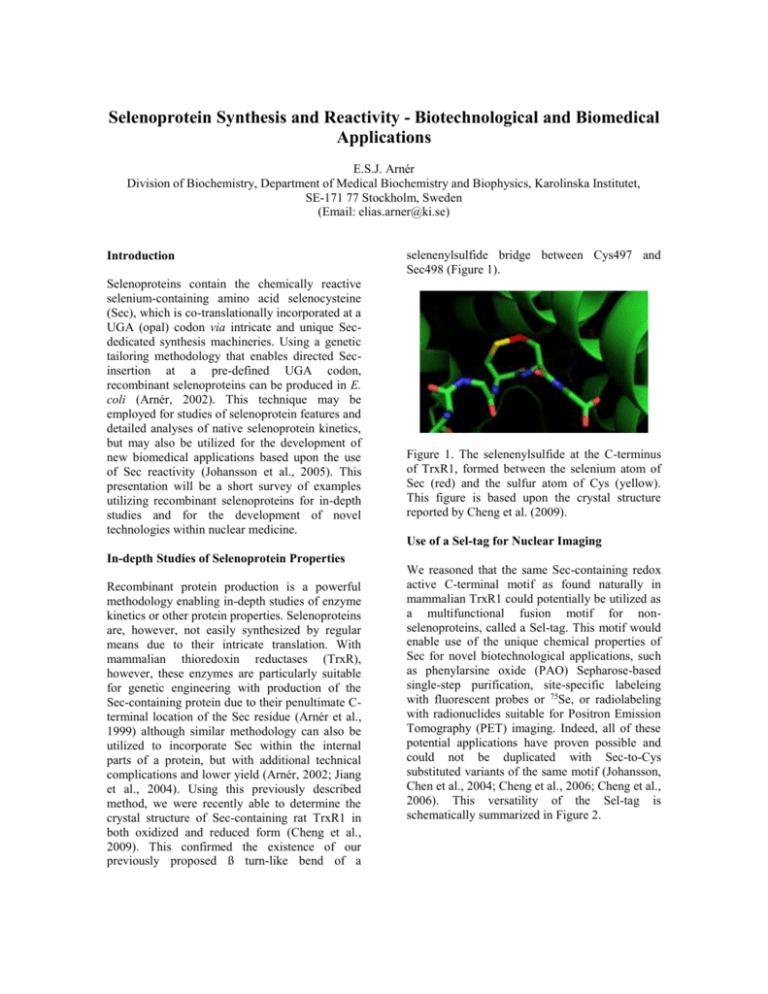
Selenoprotein Synthesis and Reactivity - Biotechnological and Biomedical Applications E.S.J. Arnér Division of Biochemistry, Department of Medical Biochemistry and Biophysics, Karolinska Institutet, SE-171 77 Stockholm, Sweden (Email: elias.arner@ki.se) Introduction Selenoproteins contain the chemically reactive selenium-containing amino acid selenocysteine (Sec), which is co-translationally incorporated at a UGA (opal) codon via intricate and unique Secdedicated synthesis machineries. Using a genetic tailoring methodology that enables directed Secinsertion at a pre-defined UGA codon, recombinant selenoproteins can be produced in E. coli (Arnér, 2002). This technique may be employed for studies of selenoprotein features and detailed analyses of native selenoprotein kinetics, but may also be utilized for the development of new biomedical applications based upon the use of Sec reactivity (Johansson et al., 2005). This presentation will be a short survey of examples utilizing recombinant selenoproteins for in-depth studies and for the development of novel technologies within nuclear medicine. selenenylsulfide bridge between Cys497 and Sec498 (Figure 1). Figure 1. The selenenylsulfide at the C-terminus of TrxR1, formed between the selenium atom of Sec (red) and the sulfur atom of Cys (yellow). This figure is based upon the crystal structure reported by Cheng et al. (2009). Use of a Sel-tag for Nuclear Imaging In-depth Studies of Selenoprotein Properties Recombinant protein production is a powerful methodology enabling in-depth studies of enzyme kinetics or other protein properties. Selenoproteins are, however, not easily synthesized by regular means due to their intricate translation. With mammalian thioredoxin reductases (TrxR), however, these enzymes are particularly suitable for genetic engineering with production of the Sec-containing protein due to their penultimate Cterminal location of the Sec residue (Arnér et al., 1999) although similar methodology can also be utilized to incorporate Sec within the internal parts of a protein, but with additional technical complications and lower yield (Arnér, 2002; Jiang et al., 2004). Using this previously described method, we were recently able to determine the crystal structure of Sec-containing rat TrxR1 in both oxidized and reduced form (Cheng et al., 2009). This confirmed the existence of our previously proposed ß turn-like bend of a We reasoned that the same Sec-containing redox active C-terminal motif as found naturally in mammalian TrxR1 could potentially be utilized as a multifunctional fusion motif for nonselenoproteins, called a Sel-tag. This motif would enable use of the unique chemical properties of Sec for novel biotechnological applications, such as phenylarsine oxide (PAO) Sepharose-based single-step purification, site-specific labeleing with fluorescent probes or 75Se, or radiolabeling with radionuclides suitable for Positron Emission Tomography (PET) imaging. Indeed, all of these potential applications have proven possible and could not be duplicated with Sec-to-Cys substituted variants of the same motif (Johansson, Chen et al., 2004; Cheng et al., 2006; Cheng et al., 2006). This versatility of the Sel-tag is schematically summarized in Figure 2. Figure 2. A scheme summarizing the structure, reactivity and diversity of a Sel-tag compared to a dithiol variant of the same motif. Figure taken from Cheng et al. (2006). Recent (yet unpublished) progress utilizing studies with 11C-labeled Sel-tagged protein ligands have proven these to be highly useful for nuclear imaging with PET. Results of these studies include the imaging of apoptotic tissue or angiogenesis in vivo using rodent models. Work for the development of clinical applications based upon this methodology is on-going. Conclusions Recent studies regarding the evolution of selenoproteins strongly suggest that selenocysteine can support functions in selenoproteins that can not easily, or not at all, be maintained by cysteine orthologues (Castellano 2009; Castellano et al., 2009). Although it is not yet completely certain, in mechanistic terms, what these unique Sec-maintained functions would be, it seems reasonable to suggest that unique chemical reactivities of Sec compared to Cys serve the evolutionary pressure to synthesize Seccontaining proteins, in spite of their costly and complex translation machineries. In the work presented here, claims are made that these unique Sec-dependent properties can be utilized for novel biomedical applications, such as PET imaging with Sel-tagged protein ligands, and that the recombinant production of selenoproteins in E coli enables the development of such technologies. References Arnér, E.S.J. 2002. Recombinant expression of mammalian selenocysteine-containing thioredoxin reductase and other selenoproteins in Escherichia coli. Methods Enzymol, 347: 226-235. Arnér, E.S.J., Sarioglu, H., Lottspeich, F., Holmgren, A., and Böck, A. 1999. High-level expression in Escherichia coli of selenocysteine-containing rat thioredoxin reductase utilizing gene fusions with engineered bacterial-type SECIS elements and co-expression with the selA, selB and selC genes. Journal Molecular Biology, 292: 1003-1016. Castellano, S. 2009. On the unique function of selenocysteine - Insights from the evolution of selenoproteins. Biochim Biophys Acta. doi:10.1016/j.bbagen.2009.03.027. Castellano, S., Andres, A. M., Bosch, E., Bayes, M., Guigó, R. and Clarket, A.G. 2009. Low exchangeability of selenocysteine, the 21st amino acid, in vertebrate proteins. Molecular Biology and Evolusion, 26(9): 2031-2040. Cheng, Q., Johansson, L., Thorell, J.O., et al. 2006. Selenolthiol and dithiol C-terminal tetrapeptide motifs for one-step purification and labeling of recombinant proteins produced in E. coli. ChemBioChem, 7: 19761981. Cheng, Q., Sandalova, T., Lindqvist, Y., and Arnér, ESJ. 2009. Crystal structure and catalysis of the selenoprotein thioredoxin reductase 1. Journal of Biological Chemistry, 284(6): 3998-4008. Cheng, Q., Stone-Elander, S., and Arnér, E.S. 2006. Tagging recombinant proteins with a Sel-tag for purification, labeling with electrophilic compounds or radiolabeling with carbon-11. Nature Protocols, 1: 604613. Jiang, Z., Arnér, E.S.J., Mu, Y., et al. 2004. Expression of selenocysteine-containing glutathione S-transferase in Escherichia coli. Biochemical and biophysical research communications, 321(1): 94-101. Johansson, L., Chen, C., Thorell, J.O., et al. 2004. Exploiting the 21st amino acid - purifying and labeling proteins by selenolate targeting. Nature Methods, 1(1): 61-66. Johansson, L., Gafvelin, G., and Arnér, E.S. 2005. Selenocysteine in proteins - properties and biotechnological use. Biochimica et biophysica acta, 1726(1): 1-13. Evidences of Selenium Deficiency in Brazil: from Soil to Human Nutrition M.F. Moraes1,*, R.M. Welch2, M.R. Nutti3, J.L.V. Carvalho3, and E. Watanabe3 1 University of Sao Paulo, Luiz de Queiroz College of Agriculture, Av. Padua dias, 11, Piracicaba, Brazil 2 USDA-ARS, Robert W. Holley Center for Agriculture and Health, Cornell University, Ithaca, USA 3 National Research Center for Food Technology, EMPRAPA, Rio de Janeiro, Brazil (*Corresponding email: moraesmf@yahoo.com.br) Introduction Cereal production has kept pace with the human population growth rate. It is anticipated that world demand for food will double in the period from 1990 - 2030, the increase being 3.5 times in developing countries (Daily et al., 1998). Malnutrition has increased, reaching almost half of the world’ population, particularly among pregnant women, infants, and children (Welch, 2008). This is partly due to soil micronutrient deficiency. Deficiencies of iron (Fe), iodine (I), selenium (Se) and zinc (Zn) are today the major concern in relation to human health especially in developing countries. According to the World Health Organization more than 2 billion people could be anemic as a consequence of Fe deficiency (Allen et al., 2006). It has been suggested that one fifth of the population is not ingesting adequate amounts of Zn (Hotz and Brown, 2004). Combs (2001) estimated that between 0.5 and 1.0 billion people could be deficient in Se. Selenium in Soils A world soil-plant study conducted by Sillanpää and Jansson (1992) included Brazil among the low soil Se countries, together with Finland. There are few reports of analyses of Se in Brazilian soils (Table 1); however the data has shown that many soils are in the deficient range. Table 1. Total Se concentration in Brazilian soils. State or city Se (µg kg-1) Reference Paiva Neto and Sao Paulo 0 - 800 Gargantini (1956) Goias 1-8 Fichtner et al. (1990) Sao Paulo Anno (2001) 38 - 212† Nova Odessa 130† M.A. Zanetti‡ Sao Paulo 68 - 220 Faria (2009) Deficient range 100 - 600 Lyons et al. (2003) †Se concentration in µg dm-3; ‡Personal communication Marcus A. Zanetti (USP). Selenium in Agricultural Food Products No complete surveys of the occurrence of Se deficiency in the Brazilian population are available. Nevertheless, Ferreira et al. (2002) reported that Se in plant foods was considered low, possibly because the soils were low in Se (Table 2). Lucci et al. (1984) determined the Se concentration in grasses and animal feedstuff from 80 locals in the State of Sao Paulo. They found low Se in grasses, with an average of 66 µg kg-1, and also Se was low in both grain and silage of maize, with 31 and 40 µg kg-1, respectively. Table 2. Se in agricultural food products of Brazil. Plant Se (µg kg-1) Reference Lucci et al. Pasture grass 66 (1984) Pasture grass 67 - 123 Anno (2001) Martens et al. 14 Dried beans S1† (2004) Martens et al. Dried beans S2 1,710 (2004) Martens et al. Dried beans S3 240 (2004) Chang et al. 30-31,700¶ Brazil nut S1‡ (1995) 1,250Chang et al. Brazil nut S2 512,000¶ (1995) Lucci et al. Maize grains 31 (1984) Ferreira et al. Food crops < 50 (2002) † Dried beans samples from: S1 - State of Rio Grande do Sul; S2 - State of Ceara; S3 - State of Para. ‡Brazil nuts samples from: S1 - States of Acre and Rondonia; S2 - States of Amazonas and Para. ¶Fresh weight Some agricultural foods have high Se concentrations, but this depends on the Se status of the soils that the crops were grown (Table 2). Unfortunately, data for the soil-Se levels in the states along with Se concentrations in agricultural products (e.g., Amazonas, Para and Ceara) is not available. Daily Selenium Intakes Studies on the intake of Se by the people in some Brazilian states have showed a low intake of Se in Sao Paulo and Mato Grosso (Table 3). However, in the Amapa and Amazonas states Se intake is adequate (Maihara et al., 2004). Table 3. Daily Se intake of Brazilian people¶. State or city Average (µg d-1) Manaus 94.5 Mato Grosso 19 Santa Catarina 52† Santa Catarina 139†† São Paulo 18 São Paulo city (Children) 26.3 Macapá city (Children) 107 Belém city (Children) 37.4 ¶ Sources: Adapted by Gonzaga et al. (2007) and Maihara et al. (2004). †Low social class. ††High social class. Although there are conclusive evidences of Se deficiencies in Brazil, it has not included in the HarvestPlus biofortification program of Brazil. More research on soil-Se levels and Se contents in agricultural products from all Brazilian states is needed. It is well known that the application of Se containing fertilizers is efficacious at correcting low Se levels in human diets (such as in Finland, New Zealand and Australia). References Allen, L., Benoist, B., Dary, O., and Hurrell, R. 2006. Guidelines on food fortification with micronutrients. WHO/FAO. Geneva. Anno, R.M. 2001. Trabalho de Conclusão do Curso de Graduação em Zootecnia. USP/FZEA. Pirassununga. Chang, J.C., Gutenmann, W.H., Reid, C.M., and Lisk, D.J. 1995. Selenium content of Brazil nuts from two geographic locations in Brazil. Chemosphere, 30: 801-802. Combs, G.F. Jr. 2001. Selenium in global food systems. British Journal of Nutrition, 85: 517-547. Daily, G., Dasgupta, P., Bolin, B. et al. 1998. Global food supply: food production, population growth, and the environment. Science, 281: 1291-1292. Faria, L.A. 2009. Levantamento sobre selênio em solos e plantas do Estado de São Paulo e sua aplicação em plantas forrageiras. Thesis, USP/FZEA. Pirassununga. Ferreira, K.S., Gomes, J.C., Bellato, C.R., and Jordão, C.P. 2002. Concentrações de selênio em alimentos consumidos no Brasil. Revista Panamericana de Salud Pública, 11:172-177. Fichtner, S.S., Paula, A.N., Jardin, E.C., Silva, E.C., and Lopes, H.O.S. 1990. Estudo da composição mineral de solos, forragens e tecido animal de bovinos do município de Rio Verde, Goiás. IV - cobre, molibdênio, selênio. Anais das Escolas de Agronomia e Veterinária, 20: 1-6. Gonzaga, I.B., Martens, A., and Cozzolino, S.M.F. 2007. Selênio. In Biodisponibilidade de nutrientes, S.M.F. Cozzolino (Ed.), Manole. Barueri, pp. 575-613. Hotz, C. and Brown, K.H. (Eds.). 2004. In Assessment of the risk of zinc deficiency in populations. Food and Nutrition Bulletin, 25: S130-S162. Lucci, C.S., Moxon, A.L., Zanetti, M.A.; Franzolin Neto, R. and Marcomini, D.G. 1984. Selênio em bovinos leiteiros do Estado de São Paulo. II. Níveis de selênio nas forragens e concentrados. Revista da Faculdade de Medicina Veterinária e Zootecnia da USP, 21: 71-76. Lyons, G., Stangoulis, J., and Graham, R. 2003. High-selenium wheat: biofortification for better health. Nutrition Research Reviews, 16: 45-60. Maihara, V.A., Gonzaga, I.B., Silva, V.L., Fávaro, D.I.T., Vasconcellos, M.B.A., and Cozzolino, S.M.F. 2004. Daily dietary selenium intake of selected Brazilian population groups. Journal of Radioanalytical and Nuclear Chemistry, 259: 465-468. Martens, A., Martens, I.B.G., and Cozzolino, S.M.F. 2004. From soil to diets of man and animals: analysis of selenium sources from different Brazilian regions by HGQT-AAS. In 9th International Conference on the Chemistry of Selenium and Tellurium. Bombay. Paiva Neto, J.E. and Gargantini, H. 1956. Dosagem de selênio no solo. Bragantia, 15: 13-16. Sillanpää, M. and Jansson, H. 1992. Status of cadmium, lead, cobalt and selenium in soils and plants of thirty countries. FAO. Rome. Welch, R.M. 2008. Linkages between trace elements in food crops and human health. In Micronutrient Deficiencies in Global Crop Production, B.J. Alloway (Ed.), Springer, New York. pp. 287-309.
